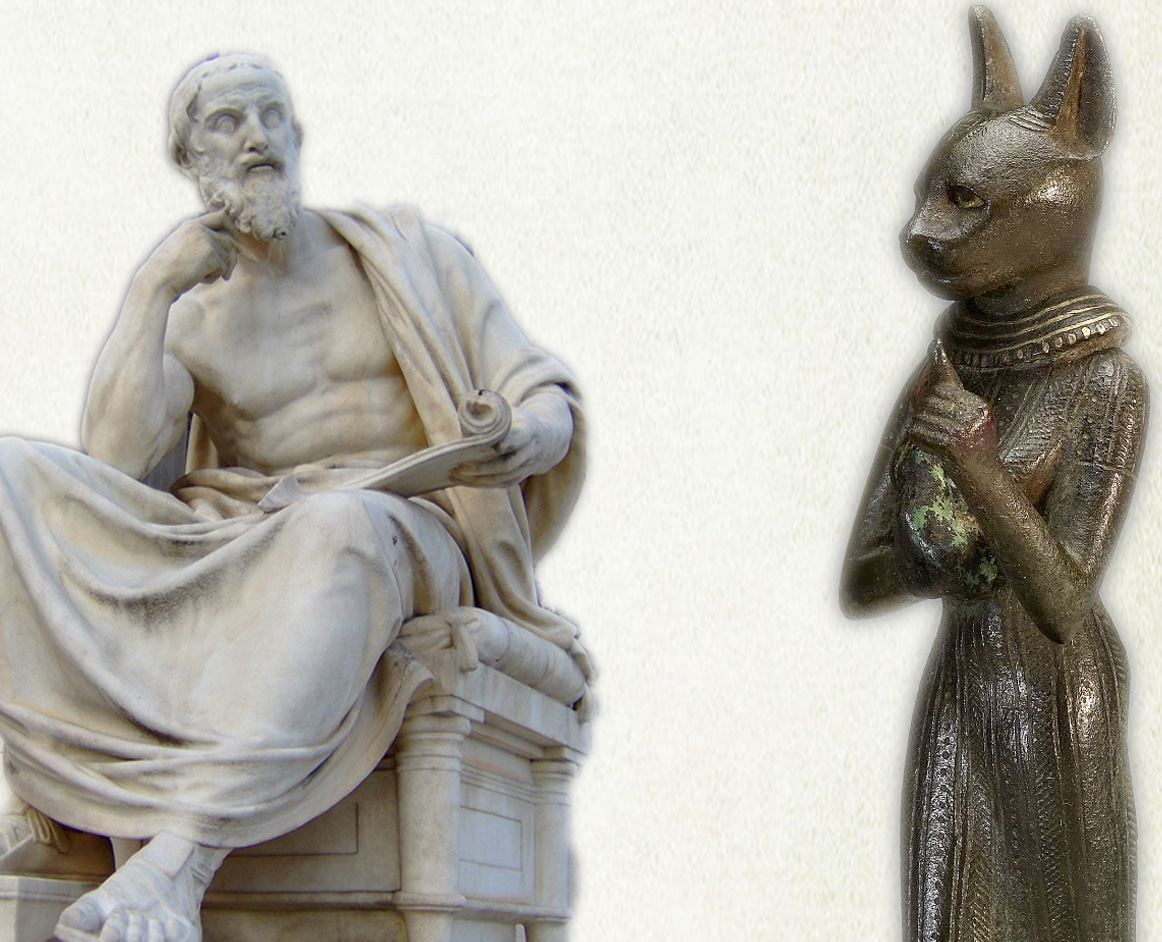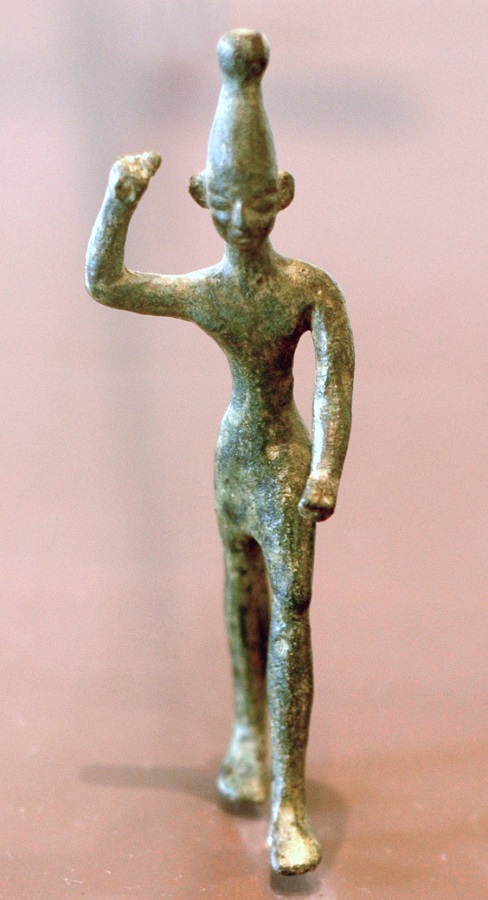Goddess Bastet and Ancient Egyptian Bel
Ba of Sha or Soul of Isis Education, Symbols and Signs, Spirituality, Power of Mind, defaultGoddess Bastet (in Slavic BeŠTija) and the Egyptian Sacred City of Cats
The Temple of Bastet was built in 2950 BC at Sakkara, Alexandria, at Bubastis.
A goddess that had a cat as a symbol, represented by the sounds “Ba” and “Sha” was worshiped for thousands of years in ancient Egypt. The Ancient Egyptian: bꜣstjt, in Slavic BeŠTija, in Coptic: Ⲟⲩⲃⲁⲥⲧⲉ/ubastə/ was an angry Goddess.
The three papyri of the 200 BC tell us of a story of the daughter of Ra, living as a mighty lioness at south of Egypt in the glowing desert heat. She is a beast, not a benevolent Goddess, an angry lioness. To please her, the worshipers use the form of a baboon (unpolite and rude humans) and music, dance and alcohol.

A bronze statue the cat wears golden earrings and nose-ring and a silver wedjat (Eye of Horus). Around 600 BC from Saqqara, Egypt in The British Museum, London.
In the 18th century, the French scholars who accompanied Napoleon on his 1798 expedition to Egypt, located the temple in Cairo, known as Tell Basta with its city Bastet.
In 1906 while building a railroad, workmen hit on a treasure buried near the remains of the temple. The treasures of great value had a golden cup sculpted to resemble lotus petals bearing the name of the 1200 BC queen Tawosret (Ta-X-os-ReT) who was the queen of Egypt during the Trojan War. Scholars believe that the queen Alcandra (aleXandra) mentioned in Homer’s Odyssey was Tawosret.
Did you know that Ancient Egyptians used to have “tatoos” of symbols of Gods tatooed on their bodies?
Bꜣstjt or BeŠTiJa was within Greece worshipped as Artemis, Ba of Sha means a Soul of ISiS (Sha) with the addition of the second 'T' to denote the feminine.
Herodotus Histories about Ancient Egyptian Ba of Sha
During his travels to Egypt, the ancient Greek historian, Herodotus (490 - 420 BC), describes the rituals to Bastet, the goddess of pleasure and fertility, desert and isolation. A gigantic cat cemetery was found in the city. The Greek historiograph Herodotus tells us about the most amazing rituals surrounding the Goddess:
“they sail men and women together, and a great multitude of each sex in every boat; and some of the women have rattles and rattle with them, while some of the men play the flute during the whole time of the voyage, and the rest, both women and men, sing and clap their hands; and when as they sail they come opposite to any city on the way they bring the boat to land, and some of the women continue to do as I have said, others cry aloud and jeer at the women in that city, some dance, and some stand up and pull up their garments...”
An interesting story within the Herodotus Histories, tell us of the members of a household whose cat passed away. They would shave their eyebrows as a sign of mourning. The mourning period was completed when the eyebrows had grown back.
Mummified cats were found throughout Egypt but most predominantly in the area of Cairo, the city of the cat goddess Bastet. Sometimes the cat mummies were placed in the tomb of their owner so they could stay together in the afterlife.

Herodotus and Bastet public domain
In 450 BC the death penalty was imposed for murdering cats, the export of cats from Egypt was also prohibited.
You probably all remember this story, when Persian forces tried to conquer the city of Pelusium in 525 BC they used cats as a weapon. Aparently, the Persians were able to simply walk through the gates of the city for the Egyptians refused to fight.
At the same time, further up North, Philip named the federation of Greek states "The Hellenes", and the Macedonians were granted two seats in the exclusively Greek League in 346 BC.
Aristotle has advised Alexander "to have regard for the Greeks as for friends and kindred" and has also in his Politics refered to Macedonians as barbarians.
The ancient Greeks themselves differentiated between “Greeks” and “Macedonians...”
Now, who were the Barbarians or Akkadians at the time?
The Akkadians (aČaDiaNs) invented the calendar and were great astronomers. They built observatories in all the great cities and have instructed their scientists to send stars observations regularly to the king. They were inventors of the Zodiac - note “Z”.
They knew of comets. During the reign of Nebu-ChadneZZar (NeBo is Sky in Slavic, Car is the King in Slavic), Ch or Č is the carrier of ČoNo (MaN in Slavic) “a comet arose shining brilliantly with a tail like the sting of scorpion extended.”
They were able to calculate eclipses and have compiled a long list of them so they can fortell the future events. “The Moon and the Sun are balanced” they would tell you or “Daily food is in the mouth of the people” “Rain falls” “The heart of the king is good”.
Their natural history was represented by lists of animals, insects, and birds, drawn up in two languages.
1360 BC Akkadian diplomatic letter found in Tell Amarna diplomatic correspondence between the Egyptian administration and its representatives in Canaan and Amurru during the New Kingdom 1360 BC
They had libraries and have created magic tablets to ward off evil spirits and demons. Libraries were arranged upon shelves and there were whole “series” one after the other. They insisted that their communication is bi-lingual.
Belonging to a period as far back as 2400 BC, the tablets were contracts with names, with the list of witnesses, the date, the name of the king and the country, with the impressions of the seals of the educated while the poor would impress the mark of his nail. Often we find signatures in Phoenician, sometimes the reverse is in Greek.
An Ancient Bank Egibi
EgiBi - eĐiBi - a company - bank - formed to carry on commerce in the city, beginning with NebuChadneZZar, for five generations to the time of Darius. The tablets are dated month after month and year after year. The use of cuneform after the Christian Era. In the British Museum, there are tablets dated 29 BC.
Babylonian Life and History by Ernest Alfred Wallis Budge, Publication date 1884, tells me that their laws were truely advanced, reading "With his seal in presence of Kiribtu, the magistrate, Edir-Bel, the magistrate and the judges." Sometimes the legal documents were carved in large tones left as a landmark, inscribed on one side with the agreement, and a whole string of curses on the person who shall dare to move it...
They found cylinders of Sargon, the finest in the British Museum, with 1,300 lines standing upright. They were “Izdubar Legends” or “Deluge tablet” that give the account of the Flood. Though they are written in Assyrian, they were translations from the Akkadian.
The enormous amount of knowledge passed to us, consciousness researchers of Babylonians.
The Babylon Gods
Babylonian Trinity - ANu, Ea, and Bel
Marduk, or Marduč is the son of Ea (
θεὸς or Δίὸς *an Ancient Greek, Homeric spelling for Zeus, or Goddess θεa).
Bel or Bog in Slavic, God in English

Baal 1400 BC Ancient Ugarit Phoenician coast Louvre
Both Bel and MerodaCH as names occur together on a tablet which applies numbers to the gods.
MerodaCh claims attention as the lord of life and light, he is fire, the “circle”, a solar hero, radiance of the son. For hymns addressed to him were written in the ancient Akkadian and our translations are made generally from the Assyrian translations.
Marduk or MerodaCH brings man's trouble to EA, fights for the man-kind, showing mercy to mankind.
The goddess spoke to him by the oracle of Arbela saying “Fear not, Esarhaddon, I am Bel, thy strength... the Moon-god at thy right hand, the Sun-god at thy left”






Goddess Bastet and Ancient Egyptian Bel No comments on Goddess Bastet and Ancient Egyptian Bel: